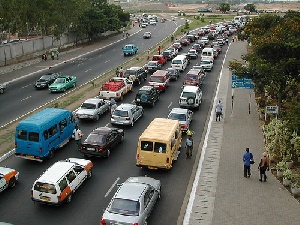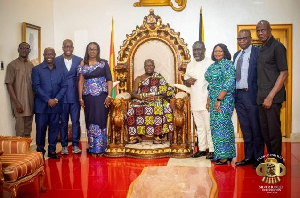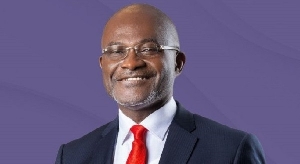- Home - News
- TWI News | TV
- Polls
- Year In Review
- News Archive
- Crime & Punishment
- Politics
- Regional
- Editorial
- Health
- Ghanaians Abroad
- Tabloid
- Africa
- Religion
- Election 2020
- Coronavirus
- News Videos | TV
- Photo Archives
- News Headlines
- Press Release
Business News of Monday, 22 April 2013
Source: B&FT
Millions needed to complete 'Gang of Six' roads
A total amount of GH¢48.4 million is needed to complete the construction of the famous 'Gang of Six' roads which were begun between 2007 and 2009, according to the Ministry of Roads and Highways.
The amount is far more than the GH¢3.96 million allocated to the projects in the 2013 budget, which effectively means that only three of the six are likely to be fully completed this year, the Ministry’s records showed.
The six projects are Extension of La-Teshie Roads (1st Infantry Brigade to Teshie Link); Emergency Road Rehab of Dansoman Main Road, Selected Collectors, Nima Highway Dadeban Road and Palace Street; Emergency Road Rehab of Spintex Road and East Legon, Roads and Culverts on Spintex Road 1; Reconstruction of Sunyani Road (Including Sofoline Interchange); Tetteh Quarshie-Madina; and Achimota-Ofankor.
The roads represent key arterial corridors into and within the Central Business Districts of Accra and Kumasi. They are intended to ease vehicular movement and traffic along the corridors.
Payment delays and additional works that were added in the course of the projects have slowed construction progress, leading to contract durations being exceeded.
The three expected to be completed this year – Extension of La Teshie Roads; Emergency Road Rehab of Dansoman Main Road and related construction; and Achimota-Ofankor – have been allocated GH¢1.66 million, which is the full amount needed for their completion.
Of the GH¢46.7 million required to finish the other three, only GH¢2.3 million has been allocated in this year’s budget.
As at December 2012, the Extension of La-Teshie Roads was 90 percent complete; the Emergency Road Rehab of Dansoman Main Road and related construction was 92 percent complete; and the Achimota-Ofankor project was “substantially completed”, the Ministry said.
The remaining three – Emergency Road Rehab of Spintex Road and East Legon, Roads and Culverts on Spintex Road 1; Reconstruction of Sunyani Road (Including Sofoline Interchange); and Tetteh Quarshie-Madina – were 75 percent, 70 percent, and 88 percent complete respectively. In 2012, a total of GH¢342.4 million was spent on the six projects, partly through bonds issued by government.
Ghana needs to boost spending on infrastructure if it is to match the standards of other middle-income countries in Africa, the World Bank has said. Road investments, expected to be worth US$5.5 billion, account for 40 percent of the government’s projected infrastructure spending for the period 2012-17, Ministry of Finance data show.
The existing 66,200 km road network has been expanding by between 7-10 percent in the last decade; yet only 41 percent is rated to be in good condition, while the high traffic density in major urban centres has increased congestion on the networks linking to these areas.
In addition, there is poor connectivity in rural areas, where only one-fourth of the rural population live within 2 km of an all-season road.
Government has said it plans to employ a mixture of budgetary funds, concessional and non-concessional loans, as well as private capital – through the public-private partnership framework – to finance its investment needs up to 2017.
With the government’s resources severely encumbered by the growing public-wage bill – which consumes around 68 percent of taxes – public-private partnership arrangements have gained increased importance among its infrastructure financing options.
Public-private partnership road projects registered with the Ministry of Finance so far include Dualisation of Accra-Kumasi and Accra-Takoradi Highways; Refurbishment and Expansion of Accra-Tema Motorway; Construction of Overpass at Teshie Link; and Western Corridor Roads Phase I (Elubo-Sunyani).











